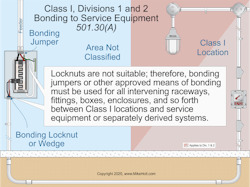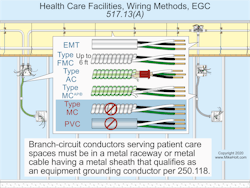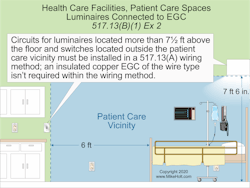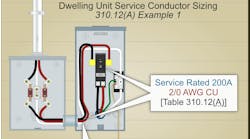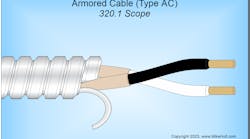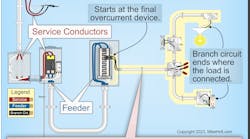The Differences Between Grounding and Bonding – Part 10 of 12
Courtesy of www.MikeHolt.com.
This article is the tenth in a 12-part series on the differences between grounding and bonding.
For bonding and grounding, six Articles from Chapter 5 are of particular note:
- Article 501 — Class I Hazardous (Classified) Locations. Flammable or combustible liquid-produced vapors or flammable gases may present the hazard of a fire or explosion.
- Article 502 — Class II Hazardous (Classified) Locations. Combustible dust may present the hazard of a fire or explosion.
- Article 503 — Class III Hazardous (Classified) Locations. Easily ignitable fibers/flyings may present the hazard of a fire or explosion.
- Article 517 — Health Care Facilities. Human health care facilities such as hospitals, nursing homes, clinics, medical and dental offices, and ambulatory care — whether permanent or movable.
- Article 547 — Agricultural Buildings. Buildings, parts of buildings, or adjacent areas, used in agriculture where excessive dust may accumulate or where a corrosive atmosphere exists.
- Article 555 — Marinas, Boatyards, Floating Buildings, and Commercial and Noncommercial Docking Facilities. Areas comprised of fixed or floating piers, wharves, docks, and other areas in marinas, boatyards, boat basins, boathouses, and similar locations intended for the repair, berthing, launching, storing, or fueling of small craft, and the mooring of floating buildings.
Class I, II, and III locations
Bonding in hazardous classified locations is intended to provide a low impedance path free from accidental arcing due to loose connections. The special bonding requirements are the same for all three Classes of location. Here, we use Art. 501 as the reference.
Because of the explosive conditions associated with electrical installations in hazardous locations [Sec. 500.5], electrical continuity of metal parts of equipment and raceways must be ensured regardless of the circuit voltage [Sec. 501.30 (see also Sec. 502.30 and Sec. 503.30)].
Locknuts are unsuitable for bonding in hazardous locations; therefore, bonding jumpers or other approved means of bonding must be used for all raceways, fittings, boxes, enclosures, etc. between Class I locations and service equipment or separately derived systems [Sec. 501.30(A)] (Fig. 1).
Regardless of the circuit voltage, electrical continuity of the metal parts of equipment and raceways in hazardous locations must be ensured by the use of bonding‑type locknuts, wedges, or bushings with bonding jumpers [Sec. 250.92(B)(4)] whether or not equipment grounding conductors of the wire type are installed in the raceway [Sec. 250.100]. Locknuts alone are not enough to serve this purpose.
A separate equipment grounding conductor (EGC) is not required if a metal raceway is used for equipment grounding. Threaded couplings and hubs made up wrench tight provide a suitable low‑impedance fault current path [Sec. 250.92(B)(2)].
Where flexible metal conduit or liquidtight flexible metal conduit is installed as permitted by Sec. 501.10(B)(2), an equipment bonding jumper of the wire type must be installed per Sec. 250.102 [Sec. 501.30(B)].
Size bonding jumpers per Table 250.122, based on the rating of the overcurrent protective device [Sec. 250.102(D)]. Where installed outside a raceway, the bonding jumpers cannot exceed 6 ft long, and they must be routed with the raceway [Sec. 250.102(E)(2)].
Health care facilities
Patient care spaces, as designated by the facility administrator, include patient rooms, examining rooms, therapy areas, treatment rooms, and some patient corridors. They do not include business offices, corridors, lounges, dining rooms, or similar areas not classified as patient care spaces [Sec. 517.2].
Equipment grounding requirements in patient care spaces are based on the concept of two different types of equipment grounding conductors. That way, if there is an installation error, the effective ground-fault current paths are not lost.
One type of EGC is “mechanical” (the wiring method), and the other is of the “wire type.” Section 517.13(A) requires the wiring method to be a metal raceway or metal cable that qualifies as an EGC per Sec. 250.118. Section 517.13(B) requires an insulated copper EGC of the wire type per Sec. 250.118.
Branch-circuit conductors serving patient care spaces must be in a metal raceway or metal cable having a metal sheath that qualifies as an EGC per Sec. 250.118 [Sec. 517.13(A)] (Fig. 2).
The metal sheath of traditional Type MC interlocked cable does not qualify as an EGC [250.118(10)(a)]; therefore, this wiring method cannot be used for circuits in patient care spaces.
The metal sheath of Type AC cable is identified as an EGC in Sec. 250.118(8) because it contains an internal bonding strip in direct contact with the metal sheath of the interlocked cable.
The following equipment must be directly connected to an insulated copper EGC that has green insulation along its entire length. Such conductors must be contained in a suitable wiring method as required in Sec. 517.13(A).
(1) The grounding contact of receptacles, other than isolated ground (IG) receptacles, must be directly connected to a green insulated copper EGC [Sec. 517.13(B)(1)(1)].
(2) Metal enclosures containing circuit conductors must be directly connected to a green insulated copper EGC [Sec. 517.13(B)(1)(2)].
(3) Noncurrent-carrying metal parts of fixed electrical equipment must be directly connected to an insulated copper EGC [Sec. 517.13(B)(1)(3)].
(4) Metal faceplates must be connected to the circuit EGC by means of a metal mounting screw(s) securing the faceplate to a metal yoke or strap of a receptacle, or to a metal outlet box [Sec. 517.13(B)(1)(4)].
Exception No. 2: Circuits for luminaires more than 7½ ft above the floor and switches outside the patient care vicinity must be installed in a Sec. 517.13(A) wiring method; an insulated copper EGC of the wire type is not required within the wiring method (Fig. 3).
Size EGCs and equipment bonding jumpers per Sec. 250.122 [Sec. 517.13(B)(2)].
An IG receptacle, if used, must not defeat the safety features of the grounding systems detailed in Sec. 517.13. Do not install an IG receptacle within a patient care vicinity [Sec. 517.16(A)].
IG receptacle(s) within the patient care space (as defined in Sec. 517.2), but outside the patient care vicinity, must comply with the following [Sec. 517.16(B)]:
(1) The equipment grounding terminal of IG receptacles must connect to an insulated EGC per Sec. 250.146(D) and be installed in a wiring method described in Sec. 517.13(A). The EGC connected to the equipment grounding terminals of the IG receptacle must have green insulation with one or more yellow stripes along its entire length.
(2) The insulated EGC required by Sec. 517.13(B)(1) must connect to the metal enclosure containing the receptacle as required by Sec. 517.13(B)(1)(2). Care should be taken in specifying a system containing isolated ground receptacles because the impedance of the effective ground-fault current path is dependent on the equipment grounding conductor(s) and does not benefit from any conduit or building structure in parallel with the EGC.
The EGC of isolated ground receptacles does not provide the benefits of the multiple equipment grounding paths required in Sec. 517.13. For that reason, IG receptacles cannot be installed in a patient care vicinity but are allowed in a patient care space where the installation complies with Sec. 517.13(A) and (B) if the isolated EGC is identified by green insulation with one or more yellow stripes.
Agricultural buildings
Where the EGC is not part of a listed cable assembly, it must be insulated when installed underground [Sec. 547.5(F)].
Equipotential planes must be installed in livestock confinement areas (indoors or outdoors) if those areas include concrete floors where metallic equipment is accessible to livestock and may become energized [Sec. 547.10(A)].
The equipotential plane must be connected to the building electrical grounding system with a solid copper bonding conductor (insulated, covered, or bare) at least 8 AWG using pressure connectors or clamps approved by the authority having jurisdiction [Sec. 547.10(B)].
The bonding requirements in Art. 547 are unique because of the sensitivity of livestock to small voltage differences, especially in wet or damp concrete animal confinement areas. Usually, the voltage difference between metal parts and the earth will be too low to present a shock hazard to people. However, livestock might detect the voltage difference if they come into contact with the metal parts. Although voltage differences may not be life-threatening to them, reports show as little as 0.5Vrms can reduce milk production.
Marinas, boatyards, and docking facilities
Metal parts in contact with the water, metal piping, and non-current-carrying metal parts likely to become energized must be connected to the grounding bus in the panelboard using a solid copper conductor (insulated, covered, or bare) at least 8 AWG [Sec. 555.13]. Make connections to bonded parts per Sec. 250.8.
The following items must be connected to an EGC run with the circuit conductors in the same raceway, cable, or trench [Sec. 555.37(A)]:
(1) Metal boxes, metal cabinets, and all other metal enclosures.
(2) Metal frames of utilization equipment.
(3) Grounding terminals of grounding-type receptacles.
The EGC must be an insulated conductor with a continuous outer finish that is either green or green with one or more yellow stripes [Sec. 555.37(B)]. Size the insulated EGC per Sec. 250.122, but at least 12 AWG [Sec. 555.37(C)].
The insulated EGC for branch circuits must terminate at a grounding terminal in a remote panelboard or the grounding terminal in the main service equipment [Sec. 555.37(D)].
Where a feeder supplies a remote panelboard, an insulated EGC must extend from a grounding terminal in the service equipment to a grounding terminal in the remote panelboard [Sec. 555.37(E)].
Special rules
Rules such as you can’t use traditional Type MC interlocked cable for circuits in patient care spaces exist because the wiring method must serve as an EGC in those spaces [Sec. 517.13]. This is a difference between this type of occupancy and, say, a law office. Type MC interlocked cable would make a fine choice for that law office. But law offices are not governed by Art. 517.
The rules for a given special occupancy stem from concepts particular to that type of occupancy. See the concepts behind the rules, and you may apply those rules more consistently.
These materials are provided to us by Mike Holt Enterprises in Leesburg, Fla. To view Code training materials offered by this company, visit www.mikeholt.com/code.

